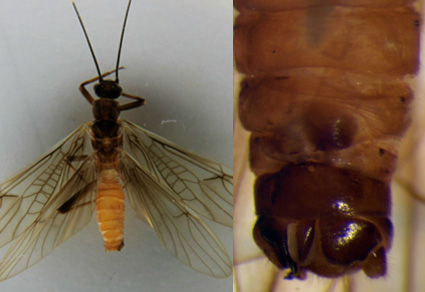Abstract
A gynandromorph of Amphinemura zonata (Okamoto, 1922) collected from Matsubara-izumi Pond in Japan is described and illustrated as the first report in the genus. The specimen exhibits bilateral gynandromorphism on abdominal sterna 7–9 and the paraprocts. Male features occur on the right half and female features on the left half. In addition, the gynandromorph is predominantly female as it retains female features on the dorsal male half of the abdomen, has eggs in the abdomen, has female-length fore wings, and lacks main male features such as an epiproct and a hypoproct on sternum 9.
References
- Aubert, J. (1958) Deux Leuctra gynandromorphes (Plécoptères Leuctridae). Mitteilungen der Schweizerischen Entomologischen Gesellschaft, 31 (3–4), 325–327.
- Baumann, R.W. (1975) Revision of the stonefly family Nemouridae (Plecoptera): a study of the world fauna at the generic level. Smithsonian Contributions to Zoology, 211, 1–74. https://doi.org/10.5479/si.00810282.211
- Cui, J.X. & Cai, W.Z. (2003) Gynandromorphism in insects. Entomological Knowledge, 40 (6), 565–570. [in Chinese, with an English abstract]
- Illies, J. (1961) Südamerikanische Notonemourinae und die Stellung der Unterfamilie im System der Plecopteren. Mitteilungen der Schweizerischen Entomologischen Gesellschaft, 34 (2), 97–126.
- Klotzek, F. (1971) Gynandromorphismus bei Leuctra-Arten des Harzes (Plecoptera-Leuctridae). Hercynia Neue Folge, 8 (2), 96–101.
- Narita, S., Pereira, R.A.S. Kjellberg, F. & Kageyama, D. (2010) Gynandromorphs and intersexes: potential to understand the mechanism of sex determination in arthropods. Terrestrial Arthropod Reviews, 3 (1), 63–96. https://doi.org/10.1163/187498310X496190
- Nebeker, A.V. & Gaufin, A.R. (1966) Gynandromorphism in Rocky Mountain stoneflies (Plecoptera: Nemouridae). Entomological News, 77 (6), 156–158.
- Nelson, C.R. & Baumann, R.W. (1987) Gynandromorphism in the winter stonefly genus Capnia (Plecoptera: Capniidae). Entomological News, 98 (5), 224–229.
- Rafael, J.A., Marques, D.W.A. & Engel, M.S. (2017) The first gynandromorph of a zorapteran and potential thelytokous parthenogenesis in a population of Zorotypus brasiliensis Silvestri (Zoraptera: Zorotypidae). Revista Brasileira de Entomologia, 61, 318–322. https://doi.org/10.1016/j.rbe.2017.09.001
- Ricker, W.E. (1965) New records and descriptions of Plecoptera (Class Insecta). Journal of the Fisheries Research Board of Canada, 22 (2), 475–501. https://doi.org/10.1139/f65-045
- Sánchez-Ortega, A. (1992) Ginandromorfismo en el genero Protonemura (Insecta: Plecoptera). Boletim da Sociedade Portuguesa de Entomologia, Supl. 3 (Actas do V Congresso Ibérico de Entomologia), 1, 113–117.
- White, M.J.D. (1973) The Chromosomes, 6th ed. Chapman and Hall, London, 214 pp.
- Yamamoto, E., Hanada, S. & Maruyama, H. (2021) Mayflies and stoneflies collected from a nature restoration pond, Matsubara Pond, Matsuyama City, Ehime Prefecture, Japan. In: Yamamoto Institute of Forest Biology (Ed.), Aquatic insects of Odamiyama and nature of Matsubara Pond. Soufusha, Matsuyama, Japan, pp. 116–123. [in Japanese]


